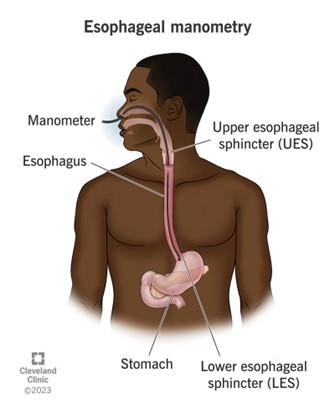Welcome to your guide on the Oesophageal Manometry test. This guide aims to explain why this test may be necessary, and what you can expect before, during, and after it.
What is an Oesophageal Manometry Test?
The Oesophageal manometry test measures the muscular function and pressures inside your oesophagus (the tube that connects your mouth to your stomach). The muscles in your oesophagus carry food and drink from your mouth down to your stomach and prevent it from rising up. [1]
This muscular tube can be affected by a variety of disorders [2]. This procedure helps your doctor to check how well your oesophagus muscles are working.
Why do I need this test?
Your doctor may order this test if you have been experiencing [3]
- chronic heartburn (that doesn’t respond to medication)
- food coming back up
- chest pain (that doesn’t come from the heart but feels like it does),
- difficulty swallowing
- a persistent cough
- nausea
- vomiting
Oesophageal Manometry allows your doctor to diagnose the root cause of your specific issue, and it’s a key step towards finding the right treatement for you.
The Procedure Step-by-Step

Credit: Cleaveland Clinic
Before the Test
You’ll need to fast (no food or drink) for about 8-10 hours before the procedure. This ensures your oesophagus is clear and ready for examination.
Your healthcare provider may also ask you to discontinue certain medications 24 hours before the test, including [4]:
- Calcium channel blockers
- Nitrates
- Opioids
- Sedatives
You should inform your doctor about all the medicines you are taking, including vitamins, herbs, and other over-the-counter drugs and supplements.
During the Test
You’ll be comfortably seated or lying down.
A thin, flexible tube (catheter) with sensors will be gently guided through your nose, down your throat, and into your oesophagus until it reaches your stomach.
A numbing medicine will be used inside your nose and throat, and at the end of the tube before it is put in, to make it less uncomfortable.
You will be asked to sip small amounts of water to test your swallowing response. During this process, the sensors on the tube (catheter) will measure how your stomach muscles are contracting [5].
After the Test
The Oesophageal Manometry is usually an outpatient procedure. At the end of the procedure, the catheter is removed, and you can go home and immediately return to your normal activities and diet unless your doctor advises otherwise.
 Credit: iStock
Credit: iStock
Please schedule a follow-up visit with your doctor to discuss the results of the test.
When Will I Get My Results?
Your doctor will receive the results of your oesophageal manometry in one to two days. He will discuss the results with you during a follow-up appointment. They’ll explain what the findings mean, and will create a personalised treatment plan if necessary. This plan might involve medication, lifestyle changes, or other procedures. [6]
Understanding Your Results
- if your swallowing problems, chest pain or heartburn, or other unusual symptoms are due to abnormal muscle function of the oesophagus.
- If your oesophagus muscles contract normally to move food or drink towards the stomach.
- If there’s any weakness in the oesophagus and the valves in the top and bottom portions of the oesophagus, causing heartburn as these two valves control how food and drink enter and exit the oesophagus.
- If there are any abnormal contractions that don’t allow food or drink to be moved effectively to the stomach.
Your doctor will discuss the results with you, and outline the next steps, if any, for your treatment plan.
Common Concerns
-
Will it hurt?
It may feel uncomfortable when the catheter is inserted, but the procedure isn’t painful.
-
Will I be awake during the procedure?
Standard Oesophageal Manometry is usually done without sedation. However, some individuals can’t tolerate having a tube put inside their nose. In such cases, patients may be slightly sedated.
-
How long will it take?
The test typically takes about 1 hour.
-
Are there any risks or side effects?
Some people experience sore throat, gagging, or nasal discomfort or, slight bleeding, but these usually resolve quickly. It is very uncommon to have a hole or perforation in the oesophagus.
Further reading
For more detailed information, consult these resources or speak to your doctor.
https://pubmed.ncbi.nlm.nih.gov
/32644663/ (Accessed Apr 11, 2024, 1.10 pm, UAE time)
https://my.clevelandclinic.org/
esophageal-manometry-test (Accessed Apr 11, 2024, 3.19 am UAE time)
https://www.hopkinsmedicine.org/
health/treatment-tests-and-therapies/
20portions%20of%20the%20esophagus.
(Accessed Apr 11, 2024, 5.38 am UAE time)
https://my.clevelandclinic.org/health/
diagnostics/4952-esophageal-manometry-test (Accessed Apr 11, 2024, 4.09 am UAE time)
books/NBK559237/#article-21337.s10 (Accessed Apr 11, 2024, 1.10 pm, UAE time)
https://www.mayoclinic.org/tests-procedures/
esophageal-manometry/about/pac-20394000 (Accessed Apr 11, 2024, 12.50 pm UAE time)
(Accessed Apr 11, 2024, 4.43 am UAE time)
https://www.hopkinsmedicine.org/health/
treatment-tests-and-therapies/esophageal-manometry#:~:text=
%20is%20a%20test,bottom%20portions
%20of%20the%20esophagus. (Accessed Apr 11, 2024, 5.38 am UAE time)
ency/article/003884.htm (Accessed Apr 11, 2024, 4.43 am UAE time)
https://www.ncbi.nlm.nih.gov/books
/NBK559237/#article-21337.s10 (Accessed Apr 11, 2024, 1.07 pm, UAE time)
Disclaimer
This guide is supplemental to the advice, care and instruction of your physician. This material is for informational purposes only and is designed to be delivered by the treating or consulting physician in conjunction with usual and appropriate instructions and explanations regarding the procedures referenced herein.





